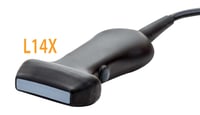In my experience, there are two types of ultrasonographers—those who tinker a lot with their image settings, and those who prefer to never adjust anything. By the very nature of my job, I’m definitely the former… but both groups can get themselves into trouble. The Tinkerers can go down a rabbit hole and find themselves even further from the results they want, and the Never-Adjusts might be missing a lot of opportunities to optimize their image quality.
How To Optimize Your Ultrasound Image
By Erika Wierman, DVM on Thu, Feb 03, 2022 @ 09:45 AM
Using Gain in Ultrasound
By Erika Wierman, DVM on Tue, May 04, 2021 @ 11:42 AM

It's funny because it’s true.... but don’t be this person! Overuse of gain can result in a washed out image and unnecessary noise. Before reaching for that gain control, consider your contact, transducer choice, and frequency.
All ultrasounds have gain control. It’s often a knob, button, and/or a series of sliders on the console, and it’s one of the most used and adjusted scanning parameters... but do you know what it really does?
Pregnancy Diagnosis in Small Ruminants
By Erika Wierman, DVM on Fri, Mar 22, 2019 @ 08:35 AM
Last month I had the pleasure of teaching at the Colorado VMA’s small ruminant meeting, and it got me thinking about some of the common misconceptions and mistakes made when using ultrasound to diagnose pregnancy in sheep and goats. I thought I might take this opportunity to highlight my top five tips.
Understanding Gain in Ultrasound
By Erika Wierman, DVM on Tue, Feb 05, 2019 @ 02:38 PM
All ultrasounds have gain control. It’s often a knob, button, and/or a series of sliders on the console, and it’s one of the most used and adjusted scanning parameters... but do you know what it really does?
Most people think of gain as a brightness adjuster, and while it’s true that turning your gain up will brighten the image, it’s helpful to understand how it actually works. Gain is a uniform amplification of the ultrasonic signal that is returning to the transducer after it travels through the tissue. So rather than brightening the monitor, the image on the screen is whitened by a uniform margin, as though the returning signal is stronger than it is, to make it easier to see.
Choosing the Correct Transducer
By Erika Wierman, DVM on Fri, Jan 18, 2019 @ 08:19 AM
 There are an overwhelming number of transducer (probe) options on the market these days, marketed for different species and applications. What do you need to consider when selecting one? Whether you are shopping for a new system or transducer, or simply deciding which of your current probes to use for a specific purpose, here are a few tips to keep in mind.
There are an overwhelming number of transducer (probe) options on the market these days, marketed for different species and applications. What do you need to consider when selecting one? Whether you are shopping for a new system or transducer, or simply deciding which of your current probes to use for a specific purpose, here are a few tips to keep in mind.
How Does Ultrasound Work?
By Erika Wierman, DVM on Tue, Dec 11, 2018 @ 02:58 PM
If you’re new to ultrasound, an image may look like nothing more than a swirling array of grey tones on the screen. Interpretation requires an understanding of anatomy and physiology, but also of how ultrasound technology functions.
Consider the sonar produced by a bat in flight. The bat emits high frequency sounds, which then bounce off of objects in its proximity and return to the bat. The animal uses the strength, direction, and timing of the returning sound to determine where those objects are and to avoid a collision.
How to use Portable Ultrasound in a Mixed Practice Veterinary Clinic?
By Mia Varra on Mon, Apr 25, 2011 @ 02:48 PM











